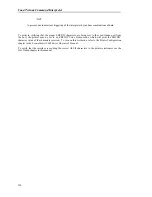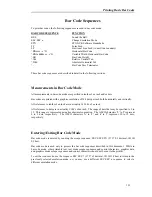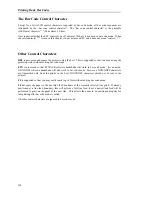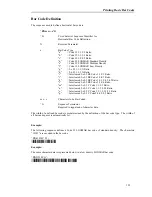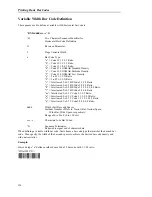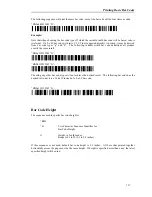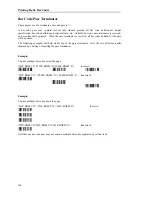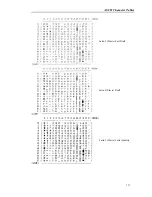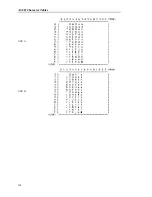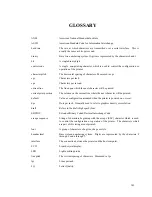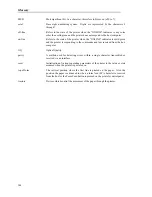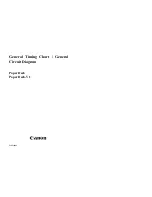
Printing Basic Bar Codes
132
Description of Supported Bar Code Types
Code 39
The Code 39 character set contains 43 characters: 0-9, A-Z, -, ., $, /, +, %, and space. A maximum bar
code density of approximately 5.5 characters per inch (using type “a”) may be obtained.
The printer automatically inserts a narrow space between all valid data characters. Invalid data
characters will cause blank space to be inserted in the bar code. A common character (*) is used for
both start and stop delimiters. The printer will automatically insert the start/stop delimiter before and
after each bar code string. Check digits are not automatically generated by the printer. If a check digit
is to be used, it must be included in the bar code data by the programmer.
2-of-5
The 2-of-5 character set contains 10 characters, the decimal digits 0-9. A maximum bar code density
of approximately 5.2 characters per inch (using type “g”) may be obtained.
The printer automatically inserts a narrow space between all valid data characters. Invalid data
characters will cause blank space to be inserted in the bar code. The printer will automatically insert
the start delimiter before and the stop delimiter after each bar code string. Check digits are not
automatically generated by the printer. If a check digit is to be used, it must be included in the bar
code data by the programmer.
Interleaved 2-of-5
Interleaved 2-of-5 bar codes encode information in both the bars and spaces in order to create a denser
bar code. There are two techniques used to perform this interleave.
One technique takes the bars of an individual character and interleaves them into the spaces to create a
narrower character. Since each character is interleaved individually, an even or odd number of
characters may be interleaved without a problem. This technique is referred to as bar/space interleave,
and is abbreviated in the previous tables as BS code.
The second and more popular technique takes the bars of two adjacent characters and interleaves them
together. All of the odd positioned characters are encoded in the bars and all of the even positioned
characters are encoded in the spaces. The interleaving process requires an even number of characters
to work correctly. This technique is referred to as character interleave and is abbreviated in the
previous tables as C code.
The two types of interleaved 2-of-5 are not compatible and bar code readers designed to read one type
will probably not read the other.
Summary of Contents for FormsMaster 8000
Page 6: ......
Page 10: ......
Page 24: ......
Page 50: ......
Page 70: ......
Page 89: ...DEC LA120 Emulation 83 VT Vertical Tab VTS Set Vertical Tab Stop...
Page 90: ......
Page 122: ......
Page 124: ......
Page 140: ...ASCII Character Tables 134 Epson FX Fast Draft Epson FX Draft Epson FX Letter Quality...
Page 141: ...ASCII Character Tables 135 PC Fast Draft PC Draft PC Letter Quality...
Page 142: ...ASCII Character Tables 136 EBCDIC Fast Draft EBCDIC Draft EBCDIC Letter Quality...
Page 144: ...ASCII Character Tables 138 OCR A OCR B...
Page 148: ......



